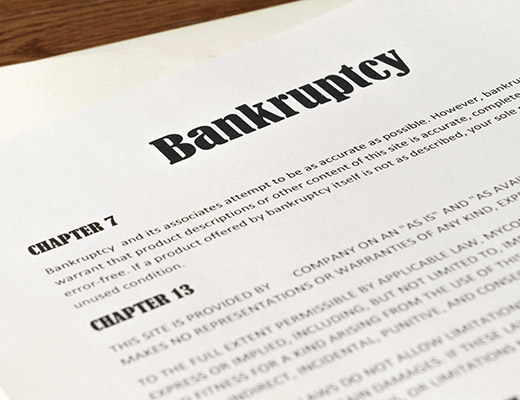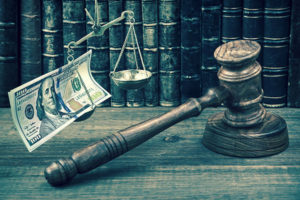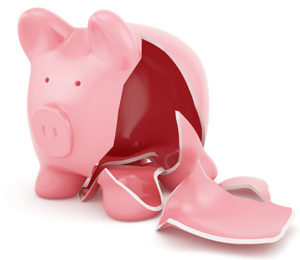What is Bankruptcy?
 Bankruptcy is a court proceeding in which a court & trustees investigate the assets & liabilities of individuals and businesses who cannot pay their costs in order to determine whether their debts should be discharged or not.
Bankruptcy is a court proceeding in which a court & trustees investigate the assets & liabilities of individuals and businesses who cannot pay their costs in order to determine whether their debts should be discharged or not.
Personal bankruptcy legislations were written to provide people whose finances fell down, a possibility to begin again. Whether it was caused bad financial decision-making or bad luck, lawmakers could see that in a capitalistic economy, consumers & organizations who failed, could use a 2nd chance.
Thinking about filing for bankruptcy? It’s good to know a few facts about how to proceed and whether or not you should proceed down this route of debt relief first. Because of its long-term negative impact on your creditworthiness, bankruptcy is often considered to be a last-resort option. You may want to look into debt settlement options as an alternative before deciding that bankruptcy is your last hope to financial salvation.
What to Know Before Filing for Bankruptcy
- There are different types of bankruptcy which can be declared. Chapter 7, 11, and 13 all affect your credit score and not all debts may be wiped out.
- Those who have filed Chapter 11 or Chapter 13 bankruptcy and whose income was affected by the Covid-19 pandemic may be able to seek modification of their repayment plan if their income has been impacted by the pandemic.
- The law mandates that when filing for bankruptcy you must complete a US Trustee approved program of credit counseling first. Your bankruptcy attorney must receive a copy of the course completion certificate before filing either a Chapter 7 or Chapter 13 bankruptcy in court.
- Also, before you obtain a bankruptcy discharge you must complete a course of debtor education which teaches you how to handle consumer credit.
- When comparing bankruptcy and debt settlement, you will see that an advantage of bankruptcy is that your eligible debts will be discharged and the burden of debt obligation will be off your shoulders.
- One of the most obvious disadvantages of filing for bankruptcy is that it will reflect on your credit report for up to ten years or more, and you will not be able to obtain a discharge for another six years.
- Unfortunately, if you have a co-signer on any of your bankruptcy debt, the co-signer will be made liable for the entire debt except in a Chapter 13 bankruptcy.
- In 2016, over 95% of Chapter 7 bankruptcies were approved, clearing close to 500,000 people of their debt. Only 22,000 chapter 7 cases were rejected that year.
- Chapter 13 bankruptcies in 2016 saw a much closer to 50% rate of rejection with 166,000 debts discharged and 164,000 cases dismissed.
- In 2015, over 97% of cases filed were for individuals, not businesses.
Looking to speak to a bankruptcy expert? Contact us at New Era Debt Solutions today.
Types of Bankruptcies
There are different types of bankruptcies for individuals and for businesses. Chapter 7 and Chapter 13 are the most common types of bankruptcy, and in 2015, over 97% of bankruptcies filed were of one of these two types.

Chapter 7 Bankruptcy
A Phase 7 personal bankruptcy will release most kinds of unsafe financial obligation. The trustee will attempt to sell any substantial nonexempt residential or commercial property in order to settle your financial institutions. A typical Chapter 7 personal bankruptcy instance takes 3 to 4 months to finish.
Keeping Property. Many of those who file Chapter 7 bankruptcy end up keeping most or all of their property. Petitioners with considerable equity or properties that are not exempt by law might lose them to repay a portion of their debt.
Income & Eligibility. Some high-income income earners will not be qualified for Chapter 7. Chapter 7 bankruptcy is available to those whose revenue is less than the average of their state, or those that can pass the means examination.
Foreclosures. Filing a Chapter 7 bankruptcy can temporarily delay a foreclosure, but unless you can catch up on your mortgage payments, the repossession/foreclosure will eventually proceed.
Chapter 13 Bankruptcy
In Phase 13 personal bankruptcy, you settle your creditors (some in full, some in part) via a Chapter 13 repayment plan. Chapter 13 repayment plans last 3-5 years depending on your income level. At the end of this period, most unsecured debt balances are erased.
Keeping Property. No home or residency is liquidated under a Phase 13 bankruptcy.
Income & Eligibility. Chapter 13 calls for a regular level of income to satisfy the monthly payments. Chapter 13 has no specific income level required, but the total of unsecured debt needs to be below $419,275 & total of secured debts below $1,257,850 (since April 1, 2019).
Foreclosures. Chapter 13 can halt a foreclosure and past due mortgage payments can be worked into the repayment plan.
Different from a Chapter 7, it is recommended that you have a lawyer help you file for Chapter 13 bankruptcy.
Need more information on filing for personal bankruptcy? Call a debt relief specialist at New Era Debt Solutions today – 1-800-527-4421
Chapter 11 Bankruptcy
If you have a company that is facing financial difficulty, a Chapter 11 bankruptcy can be used to rearrange your financial resources. Although businesses can utilize Chapter 7 for liquidation purposes, the limitations on filing a Chapter 7, particularly the fact that the business must cease operations, can make Chapter 11 bankruptcy a better option for many types of businesses. There are allowances in Chapter 11 bankruptcy for business to continue procedure while in insolvency, and there are provisions for the revising of collective bargaining arrangements and also restructuring of pensions as well as various other commitments.
Throughout the duration of the Chapter 11 bankruptcy, the trustee can run the debtor’s business. This technically means that while the trustee is running your company, it may be possible for the business to obtain loans under extremely favorable terms. Furthermore, all lawsuits against a business filing for a Chapter 11 bankruptcy are paused & either worked out as part of the personal bankruptcy, or move forward after the business returns from the Chapter 11. Unlike Chapter 13, financial institutions can elect to approve the plan for a Chapter 11 bankruptcy.
It can take months or even years for an organization to successfully emerge from Chapter 11 bankruptcy, considering that the restructuring process can be long and complex. If your company owes more than it is worth in assets, then filing a Chapter 11 can mean business owners are left with no ownership in the firm. Instead, the restructuring of the company can give ownership to the lending firms.
Chapter 9 Bankruptcy
 Chapter 9 bankruptcy is a form of debt relief created to help cities reorganize their funds without raising taxes. Financial institutions that lend to cities used to recommend that the city increase their tax rate to compensate for the debt, but this caused trouble for citizens in many indebted cities across the United States. In response to this issue, Chapter 9 bankruptcy was created.
Chapter 9 bankruptcy is a form of debt relief created to help cities reorganize their funds without raising taxes. Financial institutions that lend to cities used to recommend that the city increase their tax rate to compensate for the debt, but this caused trouble for citizens in many indebted cities across the United States. In response to this issue, Chapter 9 bankruptcy was created.
Chapter 9 enables cities to revise collective bargaining arrangements with better simplicity than what is seen in Chapter 11. State labor laws can also be surpassed with a Chapter 9. However, in some states, cities need to have authorization from the state in order to declare this type of bankruptcy.
Chapter 12 Bankruptcy
If you have particular demands as a family farmer or fisherman, you can explore chapter 12 bankruptcy as an option. Since farmers & anglers work under different situations than many normal breadwinners, there are special stipulations made for them in personal bankruptcy proceedings.
A Chapter 12 bankruptcy is similar to a Chapter 13 in many ways. The main differences are that the financial debt ceilings are much greater & a lot more exceptions are made for residential and commercial properties that can be repossessed to repay the debt.
Chapter 15 Bankruptcy
Chapter 15 bankruptcy is more focused on territory than anything else. It develops methods for teamwork with other countries in instances where a cross-border business needs to file for bankruptcy. With more & more businesses becoming international entities, stipulations for the sharing of details need to be made. While help to those in various other countries is permitted with Chapter 15 bankruptcy, it is worth noting that the extent is discretionary, as well as the fact that a United States court will decide how to proceed.
Debts Not Eligible for Discharge Through Bankruptcy
 Not all forms of debt can be expunged by filing for bankruptcy. These debts include:
Not all forms of debt can be expunged by filing for bankruptcy. These debts include:
- Spousal Support Payments
- Child Support Payments
- Some Forms of Tax Debt
- Student Loan Debt
Bankruptcy FAQs
Do You Need a Bankruptcy Lawyer to File?
While the bankruptcy laws are extremely complex and hiring a bankruptcy lawyer would be beneficial throughout the filing procedure, it is possible to file for bankruptcy without the help of a lawyer. Representing yourself in a bankruptcy proceeding is called filing “pro se” and this can be a viable option in straightforward bankruptcy cases, but it is almost always recommended that you seek legal assistance before filing.
Does Bankruptcy Erase All of Your Debts?
Depending on the types of debts you have, all or some may be erased through a bankruptcy discharge. Not all types of debt can be discharged through bankruptcy, and creditors have the opportunity to object to the discharge of any debt, so filing for bankruptcy can never guarantee that all of your debts will be erased.
Is There a Minimum Level of Debt Required to File for Bankruptcy?
While there is no minimum level of debt required to file for bankruptcy, there is a limit on how often & many times your debts can be discharged through bankruptcy, and in cases of Chapter 13 bankruptcy, there is also a maximum amount of secured and unsecured debt that can be discharged through the procedure. If you are carrying a relatively low amount of debt, it may be advisable to seek alternatives so that filing for bankruptcy can remain an open option if needed in the future.
Is it Better to Claim Bankruptcy or Settle Debt?
When the bills from your student loans, credit cards, and mortgage start piling up, you may feel like you have no other option but to declare bankruptcy. However, there’s one thing you might not have considered in your quest to avoid declaring bankruptcy: what happens if you settle debt instead?
Bankruptcy may seem like the single answer to all of your financial problems, but it’s not always as helpful as you may think. On the other hand, debt settlement can be used to reduce the amount of money you owe to creditors in addition to lowering interest rates without making it impossible to get a loan for years afterward. However, debt settlement does require commitment and setting money aside each month to pay the negotiated debt back.
Bankruptcy may be the better option in some cases if there is no possible way to set money aside to pay the negotiated debt down each month. Before you make any big financial decisions, it’s important to educate yourself on the different kinds of bankruptcy and how they’ll affect your specific situation.
Only File for Bankruptcy as a Last Resort
There are almost always better options for debt relief than bankruptcy. With a typical debt settlement case, a debtor can usually get out of debt within two to three years and will have paid between forty to sixty percent of the total debt. Their credit will improve and they will not have a bankruptcy on their credit report.
Contact a debt relief specialist at New Era Debt Solutions today to discuss your financial options.
